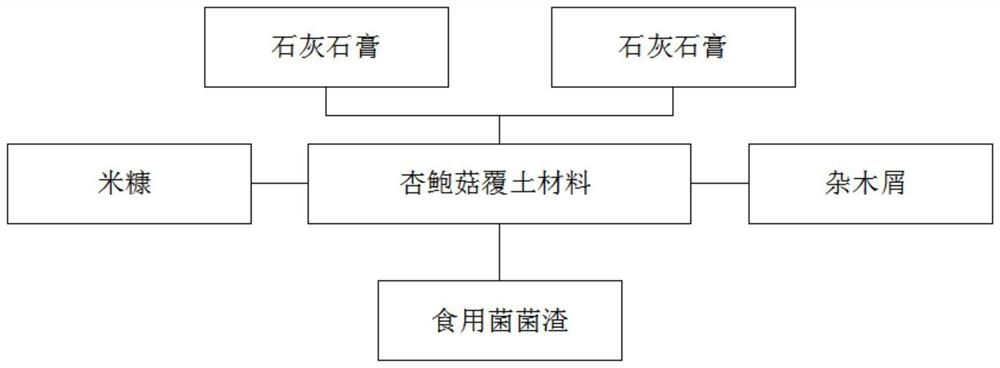Novel earthing material for pleurotus eryngii and earthing method
A soil covering material, Pleurotus eryngii technology, applied in botany equipment and methods, mushroom cultivation, bio-organic part treatment, etc., can solve the problems of low water content in mixed soil, high production cost, high labor intensity, etc., and achieve suitable nutrients , kink fast, reduce the effect of labor intensity
- Summary
- Abstract
- Description
- Claims
- Application Information
AI Technical Summary
Problems solved by technology
Method used
Image
Examples
Embodiment 1
[0019] Step 1, prepare soil covering materials: prepare 30% of charcoal soil, 11% of sawdust, 1% of lime gypsum, 15% of rice bran, and 43% of edible fungus residues in advance according to the percentages, and prepare the required amount of soil-covering materials according to the proportions. Take out the bacteria block after the bacteria from each bacteria bag;
[0020] Step 2, dividing bacteria: cut each bacterial block from the middle, cut into two small pieces to become small fungus blocks, and then bury the small fungus blocks vertically in the mushroom bed of the greenhouse, leaving 3 pieces between each small fungus block. Centimeter to 5 cm gap;
[0021] Step 3: Filling: the gaps are filled with soil-covering material, and a thin layer of soil-covering material is covered on the surface of the small bacterial block, so that the small bacterial block is slightly exposed;
[0022] Step 4: After the covering is completed, spray water and cover the plastic film, let it g...
Embodiment 2
[0024] Step 1: Prepare 38% of peat soil, 12% of miscellaneous sawdust, 1% of lime gypsum, 13% of rice bran, and 36% of edible fungus residues in advance according to the percentages, and prepare the required amount of soil-covering materials according to the proportions, and then from each fungus bag. Take out the germ blocks after they have germinated;
[0025] Step 2, dividing bacteria: cut each bacterial block from the middle, cut into two small pieces to become small fungus blocks, and then bury the small fungus blocks vertically in the mushroom bed of the greenhouse, leaving 3 pieces between each small fungus block. Centimeter to 5 cm gap;
[0026] Step 3: Filling: the gaps are filled with soil-covering material, and a thin layer of soil-covering material is covered on the surface of the small bacterial block, so that the small bacterial block is slightly exposed;
[0027] Step 4: After the covering is completed, spray water and cover the plastic film, let it grow natura...
Embodiment 3
[0029] Step 1: Prepare 48% of peat soil, 10% of sawdust, 1% of lime gypsum, 10% of rice bran, and 31% of edible fungus residues according to the percentage in advance, and prepare the required amount of soil-covering materials according to the proportions. Take out the germ blocks after they have germinated;
[0030] Step 2, dividing bacteria: cut each bacterial block from the middle, cut into two small pieces to become small fungus blocks, and then bury the small fungus blocks vertically in the mushroom bed of the greenhouse, leaving 3 pieces between each small fungus block. Centimeter to 5 cm gap;
[0031] Step 3: Filling: the gaps are filled with soil-covering material, and a thin layer of soil-covering material is covered on the surface of the small bacterial block, so that the small bacterial block is slightly exposed;
[0032] Step 4: After the covering is completed, spray water and cover the plastic film, let it grow naturally, and make the mycelium penetrate the soil....
PUM
 Login to View More
Login to View More Abstract
Description
Claims
Application Information
 Login to View More
Login to View More - R&D
- Intellectual Property
- Life Sciences
- Materials
- Tech Scout
- Unparalleled Data Quality
- Higher Quality Content
- 60% Fewer Hallucinations
Browse by: Latest US Patents, China's latest patents, Technical Efficacy Thesaurus, Application Domain, Technology Topic, Popular Technical Reports.
© 2025 PatSnap. All rights reserved.Legal|Privacy policy|Modern Slavery Act Transparency Statement|Sitemap|About US| Contact US: help@patsnap.com

